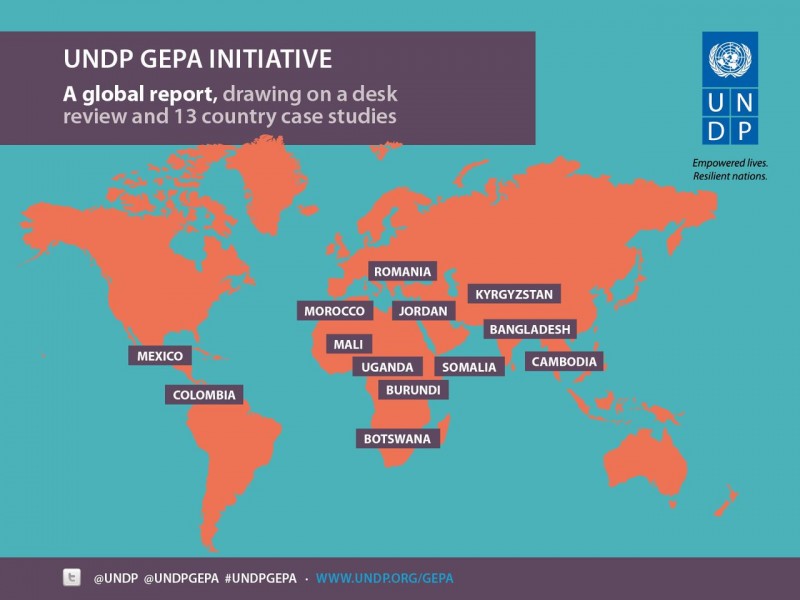Gender Equality in Public Administration – What Happens Now?

The formal launch by the United Nations Development Programme of its report Gender Equality in Public Administration is already leading to calls for new partners to step forward
In New York on 19 June, the UNDP had a live streamed launch of its new report aimed at addressing head on the issue of gender equality in the public workplace. At the launch were over 120 major experts and delegates while hundreds more watched it live online.
Launching Gender Equality in Public Administration is a triumph, but it is what happens next that is important, if the report is not to simply gather dust. So GGF gained an exclusive interview with the co-author of the report, Noella Richard, to talk about the report, next steps to advance this critical issue and, in particular, how other countries can get involved as the programme rolls out.
The GEPA Initiative
Why is there a need for the report? Public administration is the bedrock of government and the central instrument through which national policies and programmes are implemented. In an ideal world, public administration is guided by principles of fairness, accountability, justice, equality and non-discrimination, and the civil service should serve as a model where women and men equally participate and lead, including in decision-making.
However, globally, this is not yet the reality and, despite the fact that the internationally agreed target of a minimum of 30% women in leadership positions applies equally to public administration as it does to politics, women remain underrepresented in decision-making in public administration.
In response to these challenges, UNDP’s global initiative on Gender Equality in Public Administration (GEPA) was developed, with two key priorities:
(i) Supporting women’s empowerment and expanded participation and leadership in the executive branch of the state; and
(ii) Contributing to the availability of up-to-date information on gender equality in public administration and of evidence and analysis to facilitate informed policy and decision-making.
Selection of Countries
The GEPA report is part of the first phase of what will be a comprehensive and multi-disciplinary project. UNDP drew together available data and knowledge and also carried out case studies in 13 countries. As Noella Richards explains, these countries were selected to cover a broad range of development contexts around the world:
‘We didn’t just want to go with the easiest countries where we knew we would get a lot of information. We consulted with UNDP regional centres, and asked them to identify countries where there would be a need, where there were possibly existing programmes we could look at, where there would be interest from national counterparts.
‘We also wanted to cover different types of countries with different public administration traditions, different income categories, and different development contexts, including a few post-conflict countries. We wanted to ensure that country counterparts also had ownership of the methodology.’
Findings and Recommendations
The final list includes a range of countries around the world, from Bangladesh to Uganda. After putting together the data, resources and interview responses, the report revealed some key findings. These included the fact that in only 2 of the 13 countries profiled did they meet the criteria of having 30% of women in decision-making positions within the public administration. In 7 of the countries the proportion was less than 15%.
Clearly there is much to do, but in this first instance the report has three recommendations:
1. Strengthen constitutional, legislative and policy frameworks.
2. Promote institutional change within public administration.
3. Promote synergies and linkages with the broader gender equality agenda.
Your Chance to be Involved
Those are major goals to achieve, but that is just the start. The recommendations stemming from Phase I call for important changes in policies and public administrations across the world. Phase II of the GEPA initiative is starting and it will include follow-up initiatives in the case study countries and expanding the reach of the initiative by involving additional countries as well as external partners. It is here that there could be scope for involvement with countries not yet covered.
Noella explains the next steps:
‘We are starting to work on the methodology for the tracking mechanism. That is one stream of work. We are also going to disseminate our methodology used for the 13-country case studies. We’re going to share it with countries that may be interested in doing a similar assessment in their own country of women in decision making in their public administrations. Then we will look at the implementation of the recommendations.
‘Last but certainly no least, we will, this year, start piloting recommendations included in the report. That work will extend beyond the 13 countries already studied so we are keen on collaborating with other countries interested in the GEPA initiative.’
Contact details are at the bottom of this post for those interested.
Interested Parties
As well as discussing moving forward with interested countries, the UNDP is also in discussion with interested parties. Noella explains:
‘We are discussing partnerships with the OECD and other organisations. We are meeting with Ernst and Young, given their involvement through their Worldwide Index of Women as Public Sector Leaders. We are also organising another launch soon in Washington DC where we will discuss this project with members of the academia and the World Bank.’
The Challenges
While these strategic alliances are important, it is noticeable that Noella and the team are not forgetting what you always need in the end: boots on the ground. They’ve just finished a call for experts in their field, and soon they will be adding to the programme, but the team is aware of the problems still to face.
‘To find comparable data that are consistent across countries remains a challenge. Even agreeing on a definition of what the words “public administration” as well as “decision making” mean is not always easy’, says Noella. If nothing else this is a sign that the report is breaking new ground, and drawing parallels and comparisons that have not been made before.
‘That’s why we still need to identify partners in different regions. We have some strong partnerships on many fronts but we need to identify with whom we are going to develop the tracking mechanism. It’s most important for us to have resources on the ground but it is hard to find experts on the matter, which is why we are also building our roster of experts.’
Shaking Things Up
Of course a ‘one size fits all’ approach to implementing gender equality is not going to work, as the UNDP is well aware:
‘Of course, we need to change mindsets’, Noella confirms. ‘We need to shake things up. But this is no longer a taboo subject. Now the question is trying to find the right channels at country level and, depending on the context, tailoring it to local and national context.
‘In terms of changing institutional cultures we do not have a silver bullet to solve everything, but we know the range of measures which should be taken. It is also a matter of having sustained political will and resources. Of course we need a long-term approach. Just to produce the report took two years.’
However, the UN itself takes gender parity very seriously. The UN’s own Secretary General, Ban Ki-moon, recently revealed in an interview on LinkedIn that one of the two global issues he most wants to solve is that of gender parity. While he has changed the UN to a position where there is almost par between men and women at a senior level, Noella Richard highlights how the organisation will work to achieve this outside the UN.
‘We are a leadership organisation and we want to contribute substantively to this particular issue. We will create a web-based platform or portal to house resources and data that will be widely available. We hope to work with partners and champions and strengthen networks to continue raising the visibility of the importance of women’s equal participation in decision-making in public administration.’
The Case for Optimism
Above all, the UNDP team has encountered support and positive reactions in every country it has approached to work with it on advancing gender equality in the public administration. They’re aware of the long road ahead but they feel positive about the way the report has been received and about the way forward.
‘We are definitely optimistic. We have proven that progress can be made and is being made in some countries, slowly but surely. We have to engage with committed partners; we have to put in the right resources; and we have to share the knowledge so that country Y can be inspired by the practices of country X.
‘The report and case studies are an important first step. Now the real work of implementation is actually starting.’
For more information: www.undp.org/gepa
Twitter: @Noella_Richard and @UNDPGEPA
Who are the Co-Authors?
Noella Richard (pictured) is a Governance Policy Specialist with the UNDP in New York, working with the Democratic Governance Group. Noella co-authored the report with Suki Beavers, from the UNDP Gender team, who has been working on gender equality issues for more than 25 years.


















